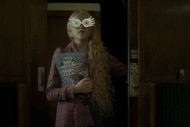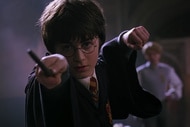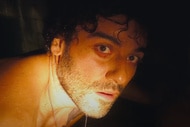Create a free profile to get unlimited access to exclusive videos, sweepstakes, and more!
E. Anne Convery finds the humanity of zombie witches in Star Wars: The Clone Wars - Stories of Light and Dark

E. Anne Convery has had a front-row seat for the evolution of Star Wars since the creation of Star Wars: The Clone Wars. With Dave Filoni for a husband, she’s seen Star Wars transition from the end of the Lucas era and through into the Disney era, bearing witness to a new renaissance. She’s been influential in many ways. Convors, the bird-like creatures that act almost as watchers in the animated Star Wars universe, are named for her. The tooka cats that have permeated The Clone Wars and Loth-cats in Star Wars Rebels had a lot to do with her and her own cats.
But with Star Wars: The Clone Wars - Stories of Light and Dark, a new collection of short stories set throughout The Clone Wars television show, Convery has taken her first step into a larger world as a firsthand creator in the universe. Her story, “Bug," springs from the events of a Clone Wars episode called “Massacre," wherein the Nightsisters of Dathomir were decimated by the Separatist Alliance.
SYFY WIRE spoke with Convery via email to discuss her story and how Star Wars changed her life.
You say in your bio that Star Wars changed your life and there are some obvious reasons for that on the surface, but would you elaborate on that?
E. Anne Convery: I’m tickled that you zeroed in on this because it was purposely pretty open-ended. I know a lot of people say it, and it's usually tied to, "I was seven years old and the opening crawl for A New Hope came up on the screen and I was never the same..."
So for me, yes, the reasons are a little more obvious. Dave [Filoni] and I moved from Los Angeles, where I grew up, to the Bay Area to work on Clone Wars, not quite two years after we got married. It was initially lonesome. But I took up studies at Sonoma State and started making the kinds of friends you make in your adult life when you're a little more discerning. I also met a lot of people at Lucasfilm who I'd say are some of the folks I respect and love most. It wasn't like other animation productions, which can come and go and have this real itinerant feeling. We had a long run with the original Clone Wars, and it really felt like family. It still does. Lots of people have stuck around or come back to work on Rebels and Resistance, and I couldn't imagine the last 15 years of my life without them.
Star Wars puts a roof over my head and affords me a lot of privileges. The greatest ones maybe being travel, and the amazing people I've got to meet through Star Wars. I mean, I GOT TO MEET TOM BAKER. I KISSED DOCTOR WHO (on the cheek, haha). And that happened because he played the Bendu. But it's not just famous people — it's everyone. I'm especially bummed there's no Star Wars Celebration this year because it's where I meet the kindest, most creative, most devoted people.
With the only original story in the book (the rest being more straight episode adaptations), where did the idea for “Bug” come from?
It’s funny because “Bug” was sort of a botched pitch. I wasn't clear, initially, that Stories of Light and Dark were retellings from different points of view, so I just wandered into the pitch with Jen Heddle (Lucasfilm Publishing) with an idea I'd been toying with. Dave had asked me, "If you wrote about Star Wars, what would you write?" and I said, "Witches!" without missing a beat.
What interests you about the Nightsisters?
I mean, what woman ISN'T interested in a Matriarchy these days, amirite? Ha! I really loved what Katie Lucas did with the Nightsisters. But I am also wired to be like, "Cool, cool, they do all this badass magic and have like, these big ceremonial urns for their magical ichor and live in a big fortress but...who MAKES all that stuff?" Those are the kinds of things I want to know. And then I had a chance to add to what already was a lot of great world-building on Dathomir, so that was my way in.
I imagine you're surrounded by Star Wars all the time, is there a point where you get tired of it?
Surprisingly, the house is mostly a Star Wars-free zone, and that's not even my active doing. I think Dave needs a little space from it, too, and he has his whole office down at work to populate with Plo Koon memorabilia. Though with quarantine, of course, work has been from home for the last five months. I feel more intimate with Star Wars than ever.
I have a Chopper figure floating around, and a cool piece of art by Ksenia Zelentsova on the wall, but it's only here or there. Really at home, it's a battle between my collections of books and bird art and knickknacks and Dave's Godzillas.
Can you tell us about your writing process on this story?
Like I said, I was interested in just who makes the artifacts of daily life in these cultures that, when we glimpse them, are engaged in all this action-packed war and magic making. So it started from there. I began with my witch, and initially was telling it in the first person from her perspective. But I switched that up pretty quickly, because my default/strength lies, I believe, in telling stories with a fairy tale vibe. So we have this Cinderella/Aschenputtel-type character, who meets a witch, and like any witch, she has her own agenda. Is she good? Is she bad? What's her story? I wanted a more dimensional Dathomirian witch than we sometimes get to see, though I think Ventress is amazing, and love the insight we get into her from Zoraida Córdova's “The Lost Nightsister.” And then I thought the best way to get that dimension was to have her tell her own story, though in the third person. So with the story within the story, we get multiple lenses on the character and what the omniscient narrator thinks she's about, what Bug thinks she's about, and what she herself thinks she's about.
I had some larger themes from Star Wars in mind. The zombie witches in "Massacre" are horrifying — here you already have a race of powerful and warlike women, and then even in death it's as if they're distilled down to their most overwhelming urges — to fight, subdue, kill, win. I think there are parallels there to the clones, and Order 66, and the disregard for their humanity and individuality. I'm always interested in who characters are beyond what other characters see as their "use." I think The Clone Wars, and Rebels, both did such a great job at exploring who the clones are as people. So zombie witches make me want to explore their humanity all the more.
I also had Shmi Skywalker on my mind, and her story about how Anakin came to be. We see precedence for that in mythologies, and close to home for many of us in the West of course, the Virgin Mary. I wondered about what it means to be a mother on your own, but with full power and agency. For Falta, it's a choice. Which doesn't make mothering any easier. But I knew I wanted to explore that theme, of a maker/mother more in depth.
Something different I did, practically, when I set out to write this story was I typed it. I usually start longhand and transcribe, but this was different. It worked out and was a positive experience so far as writing goes, and may signal a shift in how I "do writing" generally.
What do you hope people get out of the book?
Oh, you want them to get what you always get out of Star Wars at its very best — HOPE!
Star Wars: The Clone Wars - Stories of Light and Dark is available now in hardback and audio formats wherever books are sold.



























